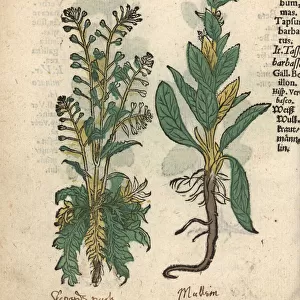Home > Mary Evans Prints Online > New Images August 2021
Field sow-thistle, Sonchus arvensis, and mouse-ear
![]()

Wall Art and Photo Gifts from Mary Evans Picture Library
Field sow-thistle, Sonchus arvensis, and mouse-ear
Field sow-thistle, Sonchus arvensis, and mouse-ear hawkweed, Hieracium pilosella. Handcoloured woodblock engraving of a botanical illustration from Adam Lonicers Krauterbuch, or Herbal, Frankfurt, 1557. This from a 17th century pirate edition or atlas of illustrations only, with captions in Latin, Greek, French, Italian, German, and in English manuscript
Mary Evans Picture Library makes available wonderful images created for people to enjoy over the centuries
Media ID 23191494
© Florilegius/Mary Evans
Adam Arvensis Captions Edition Hawkweed Herb Herbal Krauterbuch Latin Lonicer Minus Mouse Ear Pirate Woodblock Woodcut Hieracium Sonchus Sow Thistle
EDITORS COMMENTS
This exquisite handcoloured woodblock engraving showcases two common weeds of the European countryside: the Field Sow-thistle (Sonchus arvensis) and Mouse-ear Hawkweed (Hieracium pilosella). The intricate details of their leaves, stems, and flowers are beautifully rendered in this botanical illustration from Adam Lonicer's Krauterbuch, or Herbal, published in Frankfurt in 1557. The Field Sow-thistle, also known as May Sow-thistle or Greater Sow-thistle, is identified by its large, lobed, spiny leaves and yellow flower heads. It belongs to the Asteraceae family and is often found in disturbed soils and along roadsides. The plant was used in traditional medicine for various ailments, including as a diuretic, a remedy for jaundice, and as a treatment for wounds. Mouse-ear Hawkweed, also known as Mouse-ear Hawkweed or Mouse-ear Chickweed, is distinguished by its rosette of small, rounded, hairy leaves and yellow, daisy-like flowers. It is a member of the Asteraceae family and is commonly found in meadows, grasslands, and waste places. The plant was used in traditional medicine for its anti-inflammatory and astringent properties, and was also used as a poultice for skin irritations and as a treatment for diarrhea. This botanical illustration is from a 17th century pirate edition or atlas of illustrations only, with captions in Latin, Greek, French, Italian, German, and English manuscript. The intricate details of the engraving and the multiple language captions make it a valuable resource for botanical research and the study of historical botanical illustrations.
MADE IN THE USA
Safe Shipping with 30 Day Money Back Guarantee
FREE PERSONALISATION*
We are proud to offer a range of customisation features including Personalised Captions, Color Filters and Picture Zoom Tools
SECURE PAYMENTS
We happily accept a wide range of payment options so you can pay for the things you need in the way that is most convenient for you
* Options may vary by product and licensing agreement. Zoomed Pictures can be adjusted in the Cart.


